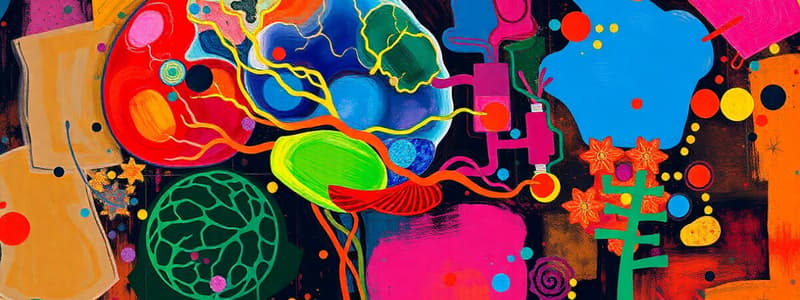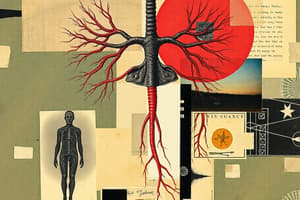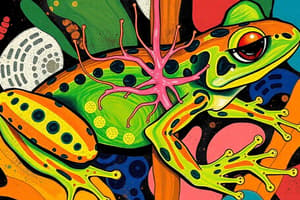Podcast
Questions and Answers
What is the role of the neural system in coordination?
What is the role of the neural system in coordination?
The neural system provides an organized network of point-to-point connections for quick coordination.
What is the role of the endocrine system in coordination?
What is the role of the endocrine system in coordination?
The endocrine system provides chemical integration through hormones.
What are the two main parts of the human neural system?
What are the two main parts of the human neural system?
- Central neural system and Peripheral neural system (correct)
- Somatic neural system and Autonomic neural system
- Visceral nervous system and Central nervous system
- Sympathetic neural system and Parasympathetic neural system
What are afferent nerve fibres, and what is their function?
What are afferent nerve fibres, and what is their function?
What are the two divisions of the peripheral nervous system?
What are the two divisions of the peripheral nervous system?
What are the two subdivisions of the autonomic nervous system?
What are the two subdivisions of the autonomic nervous system?
What are the three major parts of a neuron?
What are the three major parts of a neuron?
What are Nissl's granules, and where are they found?
What are Nissl's granules, and where are they found?
What is the function of dendrites in a neuron?
What is the function of dendrites in a neuron?
What is the function of the axon in a neuron?
What is the function of the axon in a neuron?
What are the three types of neurons based on the number of axons and dendrites?
What are the three types of neurons based on the number of axons and dendrites?
What are the two types of axons?
What are the two types of axons?
The membrane of a neuron is polarised when it is not conducting any impulse.
The membrane of a neuron is polarised when it is not conducting any impulse.
What is the action potential, and what is its role in nerve impulse conduction?
What is the action potential, and what is its role in nerve impulse conduction?
What is the resting potential?
What is the resting potential?
The impulse transmission across an electrical synapse is faster than across a chemical synapse.
The impulse transmission across an electrical synapse is faster than across a chemical synapse.
What is the synaptic cleft?
What is the synaptic cleft?
What are the two types of synapses?
What are the two types of synapses?
What is the role of neurotransmitters in chemical synapses?
What is the role of neurotransmitters in chemical synapses?
What is the central information processing organ of the human body?
What is the central information processing organ of the human body?
What are the three major parts of the human brain?
What are the three major parts of the human brain?
What is the function of the cerebrum?
What is the function of the cerebrum?
What is the corpus callosum?
What is the corpus callosum?
What is the cerebral cortex, and what is its function?
What is the cerebral cortex, and what is its function?
What are association areas in the brain?
What are association areas in the brain?
What is the function of the thalamus?
What is the function of the thalamus?
What is the limbic system, and what is its function?
What is the limbic system, and what is its function?
What is the function of the midbrain?
What is the function of the midbrain?
What is the function of the pons, cerebellum, and medulla in the hindbrain?
What is the function of the pons, cerebellum, and medulla in the hindbrain?
What is the brain stem, and what is its function?
What is the brain stem, and what is its function?
Flashcards
Neural system
Neural system
The neural system of all animals that consists of specialized cells called neurons.
What is the function of the human neural system?
What is the function of the human neural system?
Controls all the activities of the body, including voluntary movements, involuntary functions, and processing information.
Central neural system (CNS)
Central neural system (CNS)
The main part of the central nervous system (CNS), responsible for processing information, controlling movements, and higher-level functions.
Peripheral neural system (PNS)
Peripheral neural system (PNS)
Signup and view all the flashcards
Afferent nerve fibers
Afferent nerve fibers
Signup and view all the flashcards
Efferent nerve fibers
Efferent nerve fibers
Signup and view all the flashcards
Somatic neural system
Somatic neural system
Signup and view all the flashcards
Autonomic neural system
Autonomic neural system
Signup and view all the flashcards
Sympathetic neural system
Sympathetic neural system
Signup and view all the flashcards
Parasympathetic neural system
Parasympathetic neural system
Signup and view all the flashcards
Neuron
Neuron
Signup and view all the flashcards
Cell body of a neuron
Cell body of a neuron
Signup and view all the flashcards
Dendrites
Dendrites
Signup and view all the flashcards
Axon
Axon
Signup and view all the flashcards
Resting potential
Resting potential
Signup and view all the flashcards
Action potential
Action potential
Signup and view all the flashcards
Synapse
Synapse
Signup and view all the flashcards
Neurotransmitters
Neurotransmitters
Signup and view all the flashcards
Cerebrum
Cerebrum
Signup and view all the flashcards
Thalamus
Thalamus
Signup and view all the flashcards
Hypothalamus
Hypothalamus
Signup and view all the flashcards
Limbic system
Limbic system
Signup and view all the flashcards
Midbrain
Midbrain
Signup and view all the flashcards
Cerebellum
Cerebellum
Signup and view all the flashcards
Medulla
Medulla
Signup and view all the flashcards
Impulse conduction
Impulse conduction
Signup and view all the flashcards
Synaptic transmission
Synaptic transmission
Signup and view all the flashcards
Electrical synapse
Electrical synapse
Signup and view all the flashcards
Chemical synapse
Chemical synapse
Signup and view all the flashcards
Depolarization (in neuron)
Depolarization (in neuron)
Signup and view all the flashcards
Repolarization (in neuron)
Repolarization (in neuron)
Signup and view all the flashcards
Myelin sheath
Myelin sheath
Signup and view all the flashcards
Nodes of Ranvier
Nodes of Ranvier
Signup and view all the flashcards
Study Notes
Neural Control and Coordination
- The functions of organs/organ systems in the body must be coordinated to maintain homeostasis.
- Coordination is when two or more organs interact and complement each other's functions.
- Example: Physical exercise increases energy demand, requiring more oxygen. This necessitates increased respiration, heart rate, and blood flow.
- The neural and endocrine systems coordinate and integrate all organ activities.
- The neural system provides point-to-point connections for rapid coordination.
- The endocrine system uses hormones to provide chemical integration.
Neural System
- The neural system in all animals is made up of specialized cells called neurons.
- Neurons detect, receive, and transmit stimuli.
- Neural organization is simple in lower invertebrates (e.g., Hydra).
- Higher animals (e.g., vertebrates) have a more developed neural system with a more complex brain organization.
Human Neural System
- The human neural system is divided into two parts:
- Central Nervous System (CNS): Brain and spinal cord; responsible for information processing and control.
- Peripheral Nervous System (PNS): All nerves connecting CNS to other tissues/organs; transmits impulses.
- PNS fibres are of two types:
- Afferent fibers: Transmit impulses from tissues/organs to the CNS.
- Efferent fibers: Transmit regulatory impulses from CNS to tissues/organs.
- The PNS is further divided into:
- Somatic neural system: Relays impulses to skeletal muscles.
- Autonomic neural system: Relays impulses to involuntary organs and smooth muscles.
- Further divided into sympathetic and parasympathetic neural systems.
- Visceral nervous system: Part of the PNS; a complex of nerves, fibers, and ganglia that carry impulses between CNS and viscera.
Neuron as a Structural and Functional Unit
- Neurons are microscopic structures with three major parts:
- Cell body: Contains cytoplasm and organelles, including Nissl's granules.
- Dendrites: Branching fibres that receive signals and transmit them towards the cell body.
- Axon: Long fiber that conducts nerve impulses away from the cell body, ending at synaptic knobs with synaptic vesicles containing neurotransmitters.
- Myelinated axons are wrapped in a myelin sheath (Schwann cells), with gaps called Nodes of Ranvier.
- Non-myelinated axons are encased in Schwann cells but without the myelin sheath.
Generation and Conduction of Nerve Impulse
- Neurons are excitable cells because their membranes are polarized (different ion concentrations inside and outside).
- When a neuron is resting, it is more permeable to K+ and less permeable to Na+; the outside of the membrane has a positive charge relative to the inside.
- Applying a stimulus can change the permeability, leading to an influx of Na+, the inside becomes positive and changes the polarity. This is called depolarization. Repolarization follows and restores the original polarity.
- The sequence of depolarization and repolarization along the axon is called an action potential, which is conducted as a nerve impulse.
Synaptic Transmission
- At chemical synapses, the membranes of pre- and post-synaptic neurons are separated by a gap (synaptic cleft).
- Impulses are transmitted by chemicals called neurotransmitters.
- When an impulse reaches an axon terminal, neurotransmitters are released into the synaptic cleft, binding to receptors on the post-synaptic membrane, triggering another impulse.
Studying That Suits You
Use AI to generate personalized quizzes and flashcards to suit your learning preferences.




